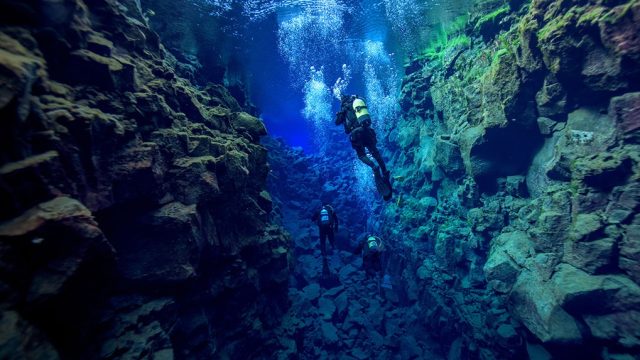The Most Unique Dive Sites on Earth
Take the plunge in one of the most amazing underwater environs on the planet.

Did you know that the human eye can't see red or yellow when 32 or more feet underwater? Or that sound travels up to five times quicker in water than it does in air, making it practically impossible to tell where a sound is coming from underwater?
Diving's popularity has been sharply rising for quite some time and looks set to continue doing so, which is exactly why the travel experts over at Insight Guides have been looking at the most unique dive sites in the world.
Dive Valhalla, Texas

Can you be much more unique than diving in an abandoned nuclear missile silo? Dive Valhalla was originally constructed during the Cold War to accommodate an 80ft-long nuclear warhead. However, and fortunately for all you divers out there, the silo was decommissioned after just two years of active service. Not long after its decommissioning, the silo slowly started filling up with around 7.6 million liters of groundwater. It's 60 feet wide and 125 feet deep and the water is clear and warm all year round.
Yonaguni Monument, Japan

In the waters off the tiny Japanese island of Yonaghuni lies a complex of mysterious rock formations that have caused great controversy ever since their discovery. Yonaghuni Island sits in almost complete isolation and is home to just 2,000 people. The mysterious rock formations, known as the Yonaguni Monument, are off the southeastern tip of the island, at depths varying from 16 to 130 feet. Here, you'll find an ancient, eerie underwater world of platforms, pillars and steps, which all predate the earliest known manmade buildings and have fueled a great deal of debate among scholars as to their origins.
Why not learn more about Japan, with a private, tailor-made vacation?
Bonne Terre Mine, Missouri

Once the world's largest lead mine, Bonne Terre was abandoned in 1961 and all equipment switched off, including pumps that dealt with encroaching groundwater levels. Over time, 5 billion liters of groundwater slowly seeped in. Bonne Terre Mine is now home to the world's largest freshwater diving complex. Nothing much has changed since 1961: Machinery, equipment and locomotives remain frozen in time in this eerie underwater world. Visibility is a consistent 100 feet, making floating around the eerie network of shafts and tunnels undoubtedly one of the most unique diving experiences.
Silfra, Iceland

Silfra boasts straddles the point where the Eurasian and North American tectonic plates join together. The Silfra Ravine, which is the exact point where these two giant land masses meet, sits like a deep scar in the ocean bedrock, and goes down 130ft. Visibility is an almost unbelievable 330 feet, giving divers and otherworldly feeling that they're floating on thin air. Thanks to the warm gulf stream, Iceland has a surprisingly mild climate; that said, summer is drier and warmer and is the best time to visit.
McMurdo Sound, Antarctica

The McMurdo Sound is a large, barren area that links the Ross Sea to the Ross Ice Shelf. The McMurdo Ice Shelf covers the sound, which is as thick as 10 feet in places. To access the cold waters beneath, a huge hole must be bored into the ice by a special drill. Once through the ice, and into the icy cold water, you must acclimatize to the harsh conditions: Just one percent of natural sunlight penetrates the thick ice. However, you will be rewarded with stunning visibility of up to 350 feet and a surreal world of craggy ice valleys and cliffs. Surprisingly, a staggering array of marine creatures thrives in this harsh, unforgiving environment. The occasional penguin can be spotted, diving off the ice into the clear water to hunt for its next meal.
Looking to explore private, tailor-made vacations? Insight Guides local experts are ready to customize your experience from start to finish. Check it out!





















